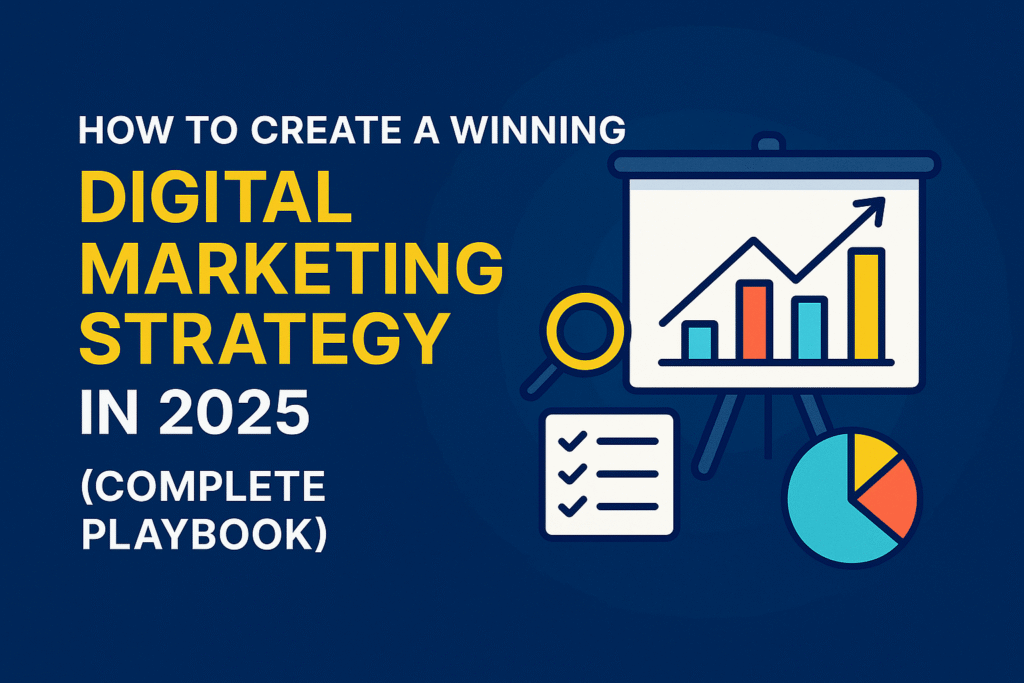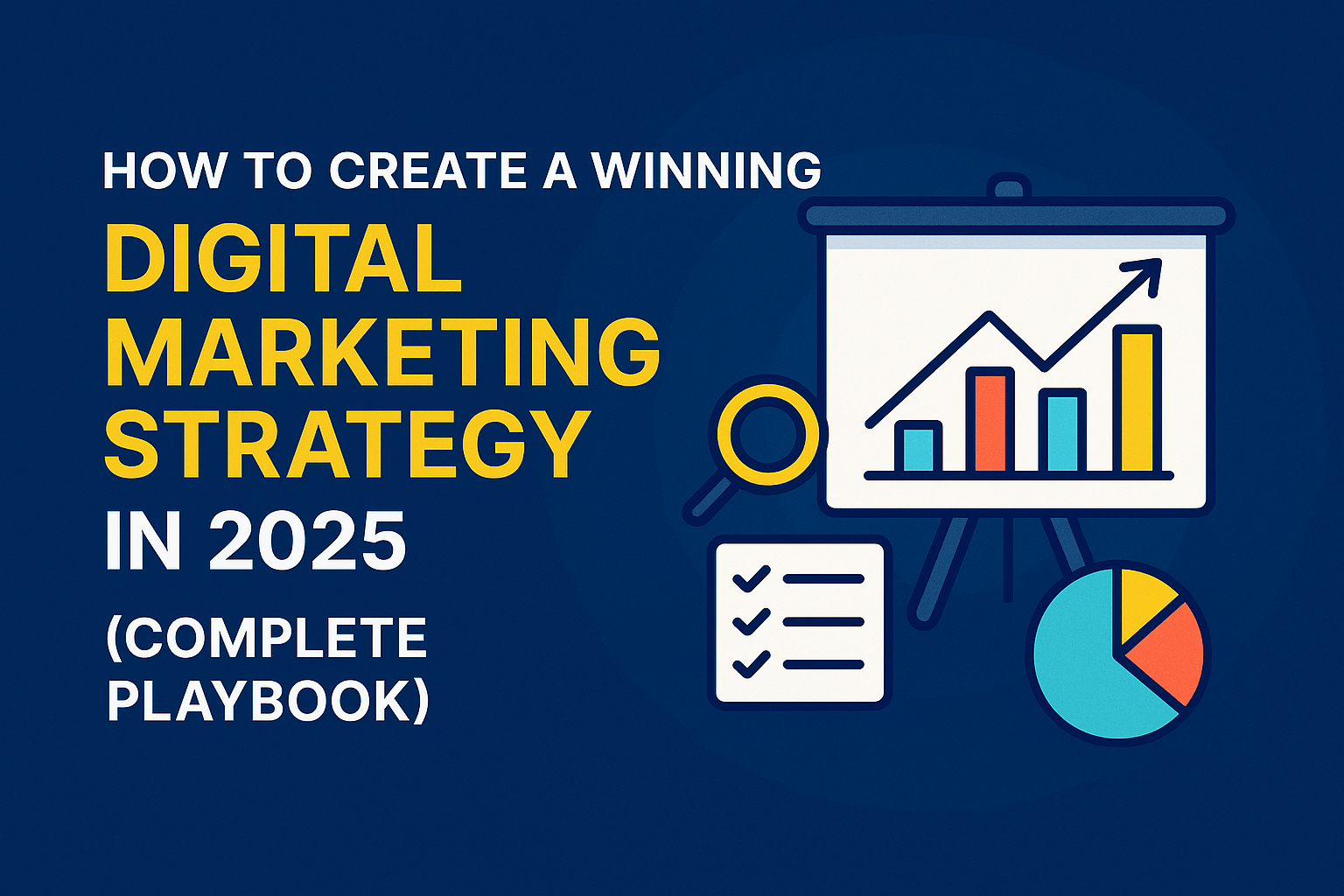1) What Is a Digital Marketing Strategy (and Why It Fails Without a System)
A digital marketing strategy is a documented plan that connects your business goals to your channels, messages, budgets, timelines, and KPIs. Most strategies fail because they’re:
-
Goal-less (no revenue linkage),
-
Channel-first (tactics without positioning),
-
Under-measured (weak analytics),
-
Or over-complicated (no weekly cadence).
Your strategy must be:
-
Revenue-linked (start from the pipeline),
-
Audience-anchored (real problems, not assumptions),
-
Channel-focused (few, not many),
-
Iterative (90-day cycles with weekly learning).
2) Set the Right Goals: Revenue-Backed, Not Vanity Metrics
Replace “we want more traffic” with “we need ₹X/month in new revenue.” Work backward:
-
Revenue target: e.g., ₹10,00,000/month
-
Average order value (AOV) / deal size: e.g., ₹10,000
-
# of monthly orders/deals needed: 100
-
Lead → Customer conversion rate: 10% (SQL→Close)
-
MQL → SQL conversion rate: 30%
-
Visitor → Lead conversion rate: 2%
Now compute:
-
Customers needed: 100
-
SQLs needed (at 10% close): 1,000
-
MQLs needed (at 30% MQL→SQL): 3,333
-
Leads needed at 2% site CVR: 1,66,650 visitors/month
This reverse funnel gives you real traffic, lead, and CPA targets.
Goal Template (OKR-Style):
-
Objective: Grow monthly revenue from ₹5L to ₹10L in 120 days.
-
KRs:
-
Achieve 1,66,650 qualified sessions/month.
-
Generate 3,333 MQLs at ≤ ₹150 CPL.
-
Close 100 deals at ≤ ₹1,500 CAC.
-
3) Know Your Buyer: ICP, JTBD & Messaging Map
Ideal Customer Profile (ICP)
-
Firmographics: Industry, size, geography, budget.
-
Pain triggers: e.g., ad wastage, low website conversions.
-
Buying committee: User, influencer, decision maker.
Jobs-To-Be-Done (JTBD)
-
Functional job: “Get more sales without wasting ad spend.”
-
Emotional job: “Feel confident our budget is used wisely.”
-
Social job: “Look good to management/stakeholders.”
Messaging Map
-
Core value proposition: “Predictable growth with performance + SEO plus CRO.”
-
Differentiators: Case studies, transparent dashboards, 90-day sprints.
-
Objections & answers: Price, timeline, proof—counter with ROI math, references, pilot.
** Deliverable:** 1-page persona + messaging grid shared with the whole team.
4) Competitor & Market Research (the Lean Way)
Skip weeks of analysis. In 1–2 days:
-
Identify top 5 direct competitors + 3 content competitors (sites ranking for your keywords even if they don’t sell your service).
-
Audit:
-
Positioning: headline, offer, proof.
-
Content moat: topic clusters, depth, internal linking.
-
Ad angles: hooks, creatives, landing pages.
-
Moats: niche focus, partnerships, pricing, community.
-
Outcome: A short doc: “What we’re up against & how we win.”
5) Channel Selection Framework: Earned, Owned, Paid
Choose 3–5 channels you can execute well for 90 days.
-
Owned: Website, email, CRM, WhatsApp lists.
-
Earned: SEO, PR mentions, UGC, referrals, community.
-
Paid: Google Search, Performance Max, Meta (Reels), YouTube, LinkedIn.
Pick with intent:
-
If you need demand capture now → Google Search + PMax.
-
If you need awareness at scale → Meta/YouTube.
-
If you need compounding growth → SEO + Email.
-
If you sell high-ticket B2B → LinkedIn + Search.
6) Budgeting & Forecasting: From ₹1 to ROI
Budget Split (starting point)
-
60% Demand Capture (Search + Brand)
-
25% Demand Gen (Meta/YouTube)
-
15% Experiments (new creatives, offers, channels)
Forecast sheet (simple):
-
Inputs: CTR, CPC/CPM, CVR, AOV, close %, margin.
-
Outputs: Impressions, clicks, leads, sales, ROAS, CAC, payback.
Update weekly. Reallocate to winners.
7) The 90-Day Execution Plan (with Weekly Cadence)
Week 0 (Prep):
-
Analytics (GA4), GTM events, pixel setup.
-
CRM stages, lead source fields, UTM standards.
-
Baseline speed (Core Web Vitals), CRO quick fixes.
Weeks 1–4 (Launch):
-
Publish 4–6 SEO hub pages + 6–10 support articles.
-
Launch Google Search (non-brand + branded) + PMax.
-
Launch 3 Meta angles × 3 creatives each (9 ads total).
-
Weekly: analyze → iterate → reallocate 10–20% budget.
Weeks 5–8 (Scale):
-
Double down on top keywords/ad groups.
-
Add retargeting (7/14/30-day windows).
-
Release 1 gated asset (case study, calculator).
-
CRO A/B test #1 (headline/hero/offer).
Weeks 9–12 (Optimize):
-
Prune underperformers (<0.5x ROAS / high CPL).
-
SEO internal-linking + add comparison pages.
-
CRO A/B test #2 (pricing table/form length).
-
Plan next 90-day cycle.
8) SEO Strategy (2025): Pillars, Hubs, and “Helpful + EEAT”
Site Architecture:
-
3–6 Hubs (pillars) that match your core services or outcomes.
-
Each hub supports 8–15 cluster posts answering intent-specific queries.
What to publish:
-
Bottom-funnel: “[Service] in [City]”, “Agency vs Freelancer”, “Pricing”, “Best [X] tools.”
-
Middle-funnel: “How to create…”, “Templates”, “Frameworks.”
-
Top-funnel: Trends, mistakes, checklists.
On-page essentials:
-
One clear H1, keyword in Title, URL, H2s where natural.
-
Intro that answers intent in first 80–100 words.
-
Schema: Organization, FAQ, Article, Product/Service where relevant.
-
Internal links: From clusters → hub, and hub → clusters.
-
Media: Original charts, examples, short videos.
EEAT Boosters:
-
Show author bio with credentials.
-
Cite data sources or benchmarks where possible.
-
Add case studies and testimonials (with names/logos).
Technical:
-
CWV: LCP <2.5s, CLS <0.1, INP <200ms.
-
Compress images, lazy-load below-the-fold, preconnect critical origins.
-
Sitemap.xml, robots.txt, canonical tags, hreflang if multi-geo.
9) Content Strategy: From Ideas → Outlines → Distribution
Idea sources: Sales FAQs, support chats, competitor gaps, “People Also Ask”, customer interviews.
Outline template:
-
Intent summary (who/why).
-
H2s covering the journey (problem → solution → proof → next step).
-
Insert data points, examples, screenshots.
-
Add CTA modules: “Get a free audit,” “Download template.”
Distribution:
-
Owned: Newsletter, WhatsApp list, homepage modules.
-
Social: LinkedIn carousels, Reels/TikTok snippets, YouTube shorts.
-
Paid: Spark/boost top performers to new audiences.
-
Syndication: Medium/Quora with canonical link.
10) Performance Ads: Google & Meta—Scalable Structures
Google Ads (Lead Gen / Services)
Campaigns:
-
Brand Search (protect + capture)
-
Non-Brand Search (solution & problem keywords)
-
Performance Max (feed creative + audience signals)
-
Remarketing (Display/Video)
Build:
-
SKAG-lite (tight themes, not one-keyword madness).
-
3–5 RSA headlines testing angles: proof, pain, outcomes, offer.
-
Landing pages matched to each intent (not homepage).
-
Negative keywords from week 1.
Optimize:
-
Add callouts, structured snippets, sitelinks.
-
Monitor search terms, prune and harvest winners.
-
Bid strategies: start with Maximize Conversions (with CPA cap once you have data) or tCPA/tROAS post-30–50 conversions.
Meta Ads (Demand Gen + Remarketing)
Structure:
-
Cold: 3 angles × 3 creatives (UGC, motion graphic, testimonial).
-
Warm: Site visitors + engagers last 30/90 days.
-
Hot: Add to cart, lead openers, video viewers 75%.
Creative angles:
-
Pain → Outcome → Proof → Offer (POPO).
-
Show before/after, social proof, and clear CTA.
-
Land on fast LPs with one action (lead or purchase).
Scale:
-
Duplicate winners into a new CBO with 10–20% higher budget.
-
Keep frequency <3 for cold, <8 for warm.
-
Refresh creatives every 10–14 days.
11) Marketing Analytics: North-Star Metrics & Attribution
North star: Revenue (or Qualified Pipeline) per channel.
Supporting KPIs:
-
CPC/CPM, CTR, CVR (channel & landing), CPL, CPA, ROAS, CAC, LTV, Payback.
Attribution approach (practical):
-
UTMs everywhere.
-
GA4 for session-based + ad platform for view-through.
-
Use first-touch vs last-touch comparison weekly; decide media mix from patterns, not one model.
12) Conversion Rate Optimization (CRO) Essentials
Quick wins:
-
Above-the-fold clarity: What you do, for whom, outcome.
-
Proof block: Logos, numbers, testimonials with specifics.
-
Offer clarity: What’s in the audit/demo? Time commitment?
-
Form friction: Fewer fields, progress bars, autofill, social proof near form.
-
Speed: Under 2.5s LCP—compress, cache, CDN.
A/B test order:
-
Headline → 2) CTA copy → 3) Hero image → 4) Social proof placement → 5) Form length.
13) Marketing Automation & CRM: From Lead to Customer
Stack idea (adaptable):
-
Website (WordPress/Shopify/Webflow)
-
GA4 + GTM
-
CRM (HubSpot/Pipedrive/Zoho)
-
Email automation (HubSpot/ActiveCampaign/Klaviyo for ecom)
-
Data studio/Looker for dashboards
-
Call tracking (if phone-heavy)
Flows:
-
Lead nurture: 5–7 emails over 14 days (problem → education → case study → offer).
-
Sales enablement: Auto-assign owner, SLAs, task queues.
-
Win-back: Inactive leads after 45–60 days with new angle/offer.
14) Brand + Creative: Consistency That Converts
-
Brand kit: Colors, type, imagery, voice, value pillars.
-
Creative system: Hook in 3 seconds, benefit in 7, proof in 15, CTA by 20.
-
Build a swipe file of best-performing ads & LPs; reuse structures, not copy.
15) Governance: SOPs, Playbooks, and Roles
Define RACI for each function:
-
Strategy, SEO, Content, Paid Media, Design, Dev, Analytics, CRM.
-
Weekly standup: 30 minutes, metrics + roadblocks + next tests.
-
Monthly review: Reallocate budget, pick 2–3 new hypotheses.
SOP library examples:
-
“How to launch a search campaign”
-
“Publishing checklist for SEO posts”
-
“CRO test design & QA”
-
“UTM & naming conventions”
16) 12-Month Roadmap Template (Keep It Simple)
Q1 (Foundation): Tracking, site speed, first 3 hubs, search + meta basics, first lead magnet.
Q2 (Scale): Double content velocity, PMax, retargeting, CRO tests, partnerships.
Q3 (Moat): Comparison pages, case studies, webinars, community/WhatsApp group.
Q4 (Defend): Refresh top assets, holiday campaigns, pricing pages revamp, NPS + referrals.
17) Common Pitfalls & How to Avoid Them
-
Too many channels: Focus on 3–5.
-
No message-market fit: Fix positioning before pouring spend.
-
Ignoring creative: Ads fail from weak angles, not budgets.
-
Measuring the wrong thing: Report revenue, not just clicks.
-
Random acts of content: Use hubs and clusters, not scattered posts.
18) KPIs Dashboard (Report This)
Weekly:
-
Spend, clicks, CTR, CPC, leads, CPL, SQLs, pipeline added, ROAS snapshot.
-
Top/worst keywords, ads, LPs; next tests.
Monthly:
-
Channel-level ROAS/CAC, LTV:CAC, payback.
-
SEO: sessions by intent, rankings for target terms, new links, content velocity.
-
CRO: test results, site speed.
19) FAQs
Q1. How long until results?
-
Paid: meaningful signals in 2–4 weeks, scale in 6–10 weeks.
-
SEO: compounding growth from 60–120 days.
-
With CRO + automation, expect improving efficiency every 30 days.
Q2. What’s a good starting budget?
-
Depends on deal size and market. For service SMBs in India, ₹1–3L/month split across Search, Meta, and content is a pragmatic start; scale with proof.
Q3. Which is better: SEO or Ads?
-
Both. Ads capture demand now; SEO compounds demand over time. Use ads to learn messaging fast, feed those insights into SEO.
Q4. How do I reduce cost per lead (CPL)?
-
Tight keyword themes, negative keywords, stronger hooks, fast LPs, better proof, and offer clarity. Refresh creatives frequently.
Q5. What’s the one thing that moves the needle most?
-
Message-market fit reflected in creative and landing pages. When the offer is obvious, channels work twice as hard.



